updated Sep 19, 2016
first posted 03-03-2014
Get a bottle and some hose and discover
How to run your vehicle on gasoline fumes.
Good clear Videos showing how easy it is for your car to get 100 miles per gallon and much more, have started appearing since 2012 or 2013. Finally, we can start experimenting with the simplest cheap parts and tools and get fantastic results! A simple vaporizer system.
a.k.a.
GasFumes.org GasolineFumes.org

John Weston has converted his car, his motorcycle, an emergency power generator, and a lawnmower to run on fumes. His car gets over 400 mpg.
Run Your Car or Truck on Gas or Diesel Vapor.
No carburetor and no fuel-injectors needed.
“Based on talks with actual engineers that work at Ford and GM, these two companies have actively discouraged any improvements in fuel efficiencies. Engineers would be threatened if they were caught tinkering with the computer systems or searching for ways to make the car engines run more efficiently.”
“CAFE standards were implemented in 1978 to force automakers to produce cars that get better mileage.”
See Decades of Automaker Roadblocks to Fuel Economy
“Stew Webb at Ford Motor company was forced to destroy carburetors that were getting 45 mpg instead of the normal 13 mpg on a heavy v8 vehicle! The plant manager told Stew that Ford was getting heat over the carburetors so they had to be removed and taken to the city dump and destroyed with a bull dozer while they watched!”
more about Stew: http://beforeitsnews.com/alternative/2013/03/us-government-stopping-75-mpg-cars-from-being-sold-in-usa-2590488.html
Read our pages about Tom Ogle and Charles Pogue who got 100 to 200 mpg on their cars, V8’s, back in the 1930’s and 1970’s
Cut our dependency on foreign oil.
how to get over 100 miles per gallon on a big car or truck.
how to get maximum fuel economy
you get more horse power and the engine runs smoother
Below are text, pictures, and videos showing exactly how it is done.
ask any mechanic,
“Any car can run on fumes. I (and countless other shadetree mechanics) have started, idled and revved quite a few engines using only a rag with some gasoline on it (don’t try this at home).” – Ike B.
“We just squirt a little gas into the carb and run the engine long enough to do any testing.” – owner of an auto repair shop
vapor: Physics. a gas at a temperature below its critical [or boiling] temperature.
fumes example: If you smell fumes in the garage, you call it gasoline vapor.
mist: Fine drops of a liquid, such as water, perfume, or medication, sprayed into the air.
From Popular Science, December 1957, page 79:
“The fuel, of course, goes along in suspension.” “… Raw, indigestible fuel slobbers into the cylinders — into some more than others.” “… Slobbering engines are fuel hogs.”
suspension: particles big enough to eventually settle.
aerosols: contain particles from 1 up to about 50 microns diameter. (1 millimeter = 1,000 microns)
octane size molecules, length: about 2 Nanometers. (1 Nanometer = 1 thousandth of 1 micron)
Our gas-guzzlers in vehicles and industry fund Arab terrorists and cause toxic air polution. The 2014 WHO report: “air pollution in 2012 caused the deaths of around 7 million people worldwide.” iags.org/fuelingterror.html: “America’s best weapon against terrorism is to decrease its dependency on foreign oil by increasing its fuel efficiency …” – Now we can experience a great increase in fuel economy!
The rich oil tycoons know but will do whatever it takes to keep the public from finding out and doing anything about it. But if we do this and help others do it. We will have defeated them.
“There are 200 million vehicles running the streets and highways here in the U.S.”
100 mpg to 400 mpg
Below are pictures and videos showing how it is done. Keep it simple, show exactly how you did it, and demo it at your local TV station!
Run your lawn mower, back-up generator,
car or truck, etc. on gas vapor, fumes.
This video makes it very clear
Proof of how a gasoline engine can run on
a very small amount of gasoline fumes
Running on vapor. the bottle is not even covered, the lid is OFF. There is no bubbling and it keeps running even when the hose is pulled out to very near the top of the bottle. Visual proof that a gasoline engine runs on only a small amount of vapor.
Tom Ogle ran a hose from the top of the tank of his lawn mower directly into the carburetor and the engine kept running for 96 hrs. on just the fumes from the fuel remaining in the small tank.
vapors running 4 liter V6 at 70 mph
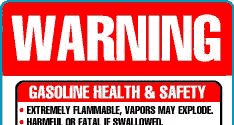
its vapors explode
admission within the US Gov.:
FEMA “All internal combustion engines actually run on vapor, not liquid. The liquid fuels used by gasoline engines are vaporized before they enter the combustion chamber above the pistons.” This claim was made in a FEMA (Federal Emergency Management Agency) report that was published in 1989
www.woodgas.net/files/FEMA_emergency_gassifer.pdf
Of course, engines actually run on vapor but the truth is liquid, not gas, is squirted into the engine, a mist, and only a small amount of the liquid vaporizes in the ~thousandth of a second before being ignited.
“… a perfectly calibrated carburetor currently makes better power and economy. Problem is being perfectly calibrated is almost impossible. All the sensors and programability of electronic injection makes a more efficient fuel system.
Progress in injectors and using direct injection into the combustion chamber at very high pressures to better break up the droplets [mist] and more energetic combustion chambers is closing the gap.” – getting the injector mist down to the fine mist of a “perfectly calibrated carburetor”
The mist sprayed into the engine by carburetors with their adjustable needle valves and the mist sprayed into the engine by modern fuel injectors is almost identical.
the fuel injection system only delivers about 10 extra horsepower at peak and yet, that is the main benefit, not economy.
The main issue with obtaining the best performance using a carburetor is that it can’t monitor the air to fuel ratio for each individual cylinder. If there was a carburetor for each cylinder then this would not be an issue. So with a carburetor, the best fuel to air ratio for each cylinder is approximated for the best performance. However, carburetors do last longer than fuel injection systems and are favored in motor sports.
Ethanol and Propane
E85 (85 percent ethanol, 15 percent gasoline) is cheaper at the pump but the mileage is lower and the net effect is that you loose. Do it for the environment – till you can win on fumes. see www.edmunds.com/fuel-economy/e85-vs-gasoline-comparison-test.html
Propane appears to be slightly more efficient – however, since it can cost around $2,500 to convert a car to propane, question it.
Bottom line: propane, E85, etc. don’t even come close to 400 mpg with a bottle and a hose.
do your own Google searches on ethanol or propane, etc. and come to your own conclusions.
Better than fumes
There are only 2 options better than running on fumes: (1st.) switching to electric. Electric is a win-win; a super simple motor with only 1 moving part (and smaller: half the size of an i.c.e.), and smaller lighter-weight batteries, and alternate sources of electricity to power them are coming. (2nd.) Running %100 on-demand-hydrogen, (see below, though you are still stuck with the antique i.c.e. engine),
iso-octane (C8H18), a.k.a. 2-Methylheptane or 2,2,4-trimethylpentane, typical of the molecular isomers found in gasoline.
2,2,4-trimethylpentane: This particular isomer of octane is the standard 100 point on the octane rating scale.
“unburned hydrocarbon molecules (mostly smaller than the ones in the original fuel) can also come out the tailpipe. These unburned hydrocarbons (plus any fuel hydrocarbons that evaporate from the fuel system before getting into the engine to be burned at all) react with nitrogen oxides (another pollutant from combustion) in the presence of sunlight to form ozone, which is a lung irritant (the “ozone layer” in the stratosphere is a shield against the sun’s ultraviolet light, but at ground level ozone is the main component of “photochemical smog”). Carbon atoms can also remain stuck to one another with few or no hydrogen atoms attached, especially during incomplete combustion of diesel fuel, producing soot.”
“This is one of the reasons alternative fuels are less polluting than gasoline and diesel: their simpler molecules are easier to burn more completely in an engine, so that less carbon monoxide, soot, and unburned hydrocarbons come out the tailpipe. In addition, any unburned hydrocarbons that are produced are less reactive than those that come from incomplete burning of gasoline or diesel fuel, and so they produce less ground-level ozone; methane in particular is almost incapable of forming smog.”
If you only wish to double (or more) your gasoline mileage, see our page A Hydrogen Generator You Can Build for a hydrogen-on-demand solution.
Very Little Is Needed

Testing:
reporter: NBC news provided five 1-gallon gas cans. a few teaspoons of gasoline in the can and tilted it at an angle.
The question, will gas vapor coming out of the can ignite and travel back to cause an explosion inside the can when the flame is place below the spout.
All five cans tested exploded.
http://www.today.com/video/today/53733179#53733179
spraying-injecting liquid gasoline into an engine is a waste of fuel.
The fuel line to your injectors or to your carburetor is to be disconnected so that only air is going into the engine, air that passes through your container of fumes.
gasoline vapor concentration by volume:
The minimum concentration of a particular combustible gas or vapor necessary to support its combustion in air is defined as the Lower Explosive Limit (LEL) for that gas (examples: hydrogen, butane, propane, gasoline fumes, etc.). Below this level, the mixture is too “lean” to burn. The maximum concentration of a gas or vapor that will burn in air is defined as the Upper Explosive Limit (UEL).
At the UEL, is the most efficient – greatest explosion. Beyond that, less oxygen is available for combustion. (and the excess gas, fumes, is wasted)
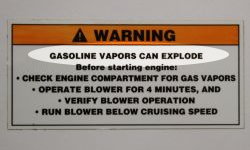
LEL for gasoline vapor: 1.2%
UEL for gasoline vapor: 7.1%
LEL for Propane: 2.1%
UEL for Propane: 9.5%
LEL for Hydrogen: 4.0%
UEL for Hydrogen: 75.0%
from Gas Data Book, 7th edition, copyright 2001 by
Matheson Gas Products, and from Bulletin 627, Flammability Characteristics of Combustible Gases and Vapors, copyright 1965 by U.S.Department of the Interior, Bureau of Mines. All concentrations in percent by volume.
In the U.S., “Summer gasoline and winter gasoline are actually different blends, because cars run better if the fuel is roughly optimized for the ambient temperature. Winter gasoline will produce a lot of vapors in the summer, possibly even boiling off in your tank. Summer gasoline doesn’t vaporize as much, making it too hard to ignite when the engine is cold” [and harder to vaporize completely in a container].
“So, you should try to change your gas when the seasons change. Refineries switch blends in spring and fall. Gasoline usually doesn’t hold up an entire year. Replace your gas at the start of summer, and at the start of winter. That way it’s always fresh.”
Ryan Carlyle, BSChE, engineer at an oil company
http://www.quora.com/How-long-does-gasoline-last-in-a-sealed-containerFor us, this means that winter gasoline vaporizes more easily. – editor
Lawn Mower Running a lot more efficiently on Vapor Only – fumes
Joe Bleau
so simple: A (peanut butter!) bottle (the red lid) with some gasoline in the bottom, a hose from the top of the bottle to the air intake of the engine and a hose letting air into the bottle, (long enough to extend down into the gas so that it bubbles through the gas – which is overkill, way too much, actually). That’s it!
improvement: place the longer tube down just low enough for the air to blow across the top of the surface of the gas, not bubble down into the gas.
Direct Injection
“In a direct-injection system, air comes in via the intake manifold where the air/acceleration is controlled with a butterfly valve in a throttle body.”
in other words,
“In fuel injected engines, the throttle body controls the amount of air flowing into the engine [controls acceleration] with a butterfly valve and is usually located at the intake manifold.” See sample engine photo and explanations at www.GreatAutoHelp.com/sensor-location/3800.htmlin other words,
keep only the butterfly valve of a carb. to control acceleration [a “throttle body”] and then inject the fuel with “fuel injectors” directly into the cylinders.today
quit injecting, wasting, fuel; just draw in a little vapor off the surface of a small gasoline container.
so simple: A bottle with some gasoline in the bottom, a hose from the top of the bottle to the air intake of the engine (with a valve on it to control the engine) and 3 more hoses (arbitrary) letting air into the bottle, long enough to extend down over the gas. (bubbles into: too much) That’s it.
“Any car can idle on fumes. I (and countless other shadetree mechanics) have started, idled and revved quite a few engines using only a rag with some gasoline on it (don’t try this at home).”
“The gasoline liquid doesn’t undergo a phase change in those injectors. High pressure, tiny holes, and even the high frequency of the operation causes fuel to turn into very tiny droplets, but still quite liquid, not a gas, not “fumes.” It’s all about maximizing the surface area to mass ratio of the fuel to get a more efficient burn (or hotter burn, or more controllable burn) for the same amount of fuel.” Fumes denote fuel in a gas phase (as in solid, liquid, gas). It sounds pedantic but it’s important to note the difference, for good reason”.
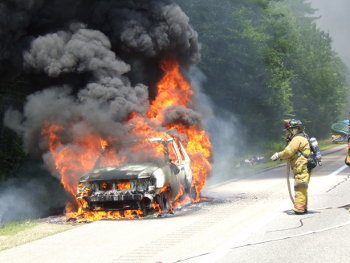
“… fuel is sprayed into the carburetor in a fine mist.”
Those [fuel injected] tiny droplets are still a long way from being single molecule “fumes” or “vapors”. They are still a “mist”. They are still not the vapor that came off that rag the mechanic used in his auto repair shop nor the vapor that comes off the surface of the gasoline in the bottom of the gasoline container.
use a flashback arrestor to protect against the risk of explosion – that no friend tries smoking around your engine when you are testing . . . or at a gas station . . . or etc.! . . . see below.
Running your car or truck on gasoline vapor
Published on Mar 29, 2012

so simple: A bucket with some gasoline in the bottom, a plastic pipe from the top of the bucket to the air intake of the engine and 1 pipe letting air into the bucket, long enough to extend down over [not into] the gas so that it [only blows over the gas -and its safer]. That’s it. He has room in the side of his car’s engine compartment for the bucket and the car is now getting great gas mileage, running on fumes.
“This video shows the inner chamber of the vaporizer. As you can see I have the air inlet pipe which has many little holes drilled into the cap which is placed at the bottom of the pipe. The air outlet pipe has larger holes about 1/2” in diameter drilled into the side of it to allow the air and gasoline vapor to be sucked into the engine through the air intake on my Buick.
“The fuel is completely shut off. All my car is running on is the gasoline vapor created from the air being pulled through the pipe which is submersed under the gasoline. This submersion creates a cold gasoline vapor which is then sucked through the secondary pipe into my air intake. I do have a secondary air inlet port installed on the secondary pipe it is placed between the vapor outlet pipe and the air intake. This secondary air inlet allows me to adjust the air to fuel mixture as the RPM (Revolutions Per Minute) rise the need for more air arises. This secondary air inlet allows that extra air to be pulled in freely with no restriction from the pipe which is submerged under the gasoline.”
. . . note: “Running the vehicle off vapor-fumes actually reduced the cylinder head temp. by an average of 10 degrees F.”
– Tyson Capel
a 2006 Buick
“This video contains footage of my original gasoline vaporizer. New discoveries are being made in this footage. I did a test run at a later date using a method similar to this the method was different but had similar concepts as what you see in this footage. I will reveal my new design once I work out all the bugs do further testing and have more subscribers and views to my videos so I can insure this information will reach millions of people so that there is no way it can be suppressed. Please share this video, please subscribe please so that I may get this information out as soon as possible. I need more supporters and subscribers before I release the completed design.”
“There is some confusion out there about having to adjust the timing, change the time the injectors inject the vapor etc. From the tests I have done there is no need for this. Gasoline vapor still burns at the same rate as liquid gasoline being injected into you engine. We need to remember that even with liquid gas being injected the only thing that burns is the vapor coming off the liquid that is why injecting a liquid is so inefficient.”
. . . “please contribute by sharing your knowledge. Thanks for all the support!” – see more on youtube.
simplest setup yet?
A fuel-injected car
7-26-2014
“Save on Gasoline Run Your Car On Fumes”
I saw Joshua Lineberry on YouTube run his Dodge on gasoline fumes. So I thought I’d give it a shot. I made up a rough prototype just to see if it would work, too easy thanks Joshua. I’ll do another video when I get an idea of the mileage I can get. About 10 years ago I thought about this concept but thought you would have to heat the fuel to get the vapour’s you’d need. Note: Unlike Joshua’s Dodge which has a carburetor my car has fuel injection which doesn’t seem to be a problem. Just realized when blocking the hose I was starving the engine of air as well. Will check to make sure even without the fuel pump working it can’t pull gas up from the tank. … Thanks for watching.
– Paul Freeman
Flashback Arrestor
#1 Safety feature for gas vapor – – the flame will not pass through the screen!
“Use this on the intake to the engine manifold … that way if there is a flash it will be contained. They cost like 50 cents from the dollar store.”
“I had a backfire a while ago with the chevy cavalier due to … i’m not sure, but it hasn’t done it since. luckily i had the screen on the intake manifold directly above the butterfly valve … it backfired, i heard the air shoot back into the chamber and nothing else… would have been bad if it wasn’t stopped right where it started.”
“Take the time to put the proper safety precautions into the design.”
“thin tubes needed to be only about as long as their diameter to prevent fire from traveling their length. The logical end point was fine metal mesh, which you could think of like thousands of very short tubes arranged in a grid.”
www.popsci.com/diy/article/2009-12/gray-matter-built-lamp-doesnt-explode
cut a piece of screen wire.
Feb 19, 2014; a 1995 Toyota Corolla
Oct 4, 2011
It is a first test, the hose runs to a bottle over on a table and the owner spends a of time showing the setup.
Running a tractor on diesel fumes – vapor
*** We were just proving if it can run on vapors then we can deliver it to the engine through a Vapor injector one day. ***
At this point we are actually running on the vapors. You can hear the sound of the diesel engine taking in vapors through the air intake stream. It is not the recommended delivery because the timing is not correct for the proper firing. You can hear some pinging sound regarding pre-ignition.
GO TO 16:42 in the video where it is actually running on vapors.
In the beginning of the video with me not being an expert in diesel engines I forgot to turn off the fuel injector pump. Eventually we seen the mistake and then we were running on the diesel vapor carburetor. This was our very first run and we never did this before and you are seeing it for the first time like we are doing for the first time. If there’s any mistakes or problems we were seeing it and you are seeing it on video. We are happy with the results and now it is time to fine tune the system. After the video was completed we totally made some major changes getting rid of the flexible cap and change it over to a hard top and more.https://www.youtube.com/watch?v=kjMCdg3pt20
Jun 1, 2004
Diesel Fumes – vapor
I was with San Diego Truck Center for many years. We converted diesel engines over to “vapor” fuel for less than $1,000. We ran them on methane, butane, propane, and natural gas.
It is called “pilot fuel” or “dual fuel,” and most diesel engines can be run on diesel and any of the vapor fuels. The diesel engine needs to run on at least 10% diesel for ignition, and the remainder can be any of the above. The nice thing about it: If one runs out of the other, the diesel injection pump makes up the difference with straight diesel with no adjustments. Running vapor fuel in a diesel engine as pilot fuel doubles or even triples engine life. The engine runs cooler and quieter.
The “old boys” from the ’40s use to carry a propane tank in the cab of the truck. When they needed extra power, they had a hose to the air cleaner and just opened the propane valve and got extra power for the pull.
I would like to see the trucking industry get into this technology. It is only the inconvenience of carrying another fuel tank and putting the IMCO regulator on for the duel fuel setup.
William Hamel
Engine application engineer
www.trailer-bodybuilders.com/archive/vapor-fuel-technologys-clear-advantages
“Running on used vegetable oil”
Article from The Journal News, Monday, October 25, 2004Cruising in his turbocharged Ford F-250 pickup truck, Jonathan Pratt chuckles to himself as he drives past a gas station with ever-increasing diesel prices.
Pratt’s truck has been running off fryer oil for six weeks. His truck has been problem-free, and he says that he will save hundreds of dollars this year by sidestepping the gas station. Plus, vegetable oil is a renewable energy source (mostly soybean crops), and emits fewer fumes than diesel or petroleum . . .
Restaurant owners are more than happy to give away their used oil, Carven says.
“Most of (my customers) do get oil from the restaurants. The waste vegetable oil from deep frying is a pretty abundant waste product, especially in this country,” Carven says. “Some restaurants produce 50 gallons a day. Because it’s a waste product and it can’t be thrown in landfills, restaurants have to pay special contracted companies to collect and dispose of the oil.”
Still, a conversion kit, which typically costs between $400 and $1,000, doesn’t completely erase the need for diesel. A miniscule amount of diesel fuel is needed to start the car – cold vegetable oil is too viscous to run smoothly .
The kit heats up the vegetable oil to the proper viscosity, and allows the driver to switch from diesel to vegetable oil by literally flipping a switch on the dashboard.
The car can’t be started on vegetable oil, so it has to be switched back to diesel at the end of a drive, to purge veggie oil from the car’s fuel lines.
The kit also comes with a separate fuel tank for the vegetable oil, which can be kept in a truck bed or below the trunk, where the flat tire usually rests.
Pratt says the diesel fuel gauge hasn’t moved since he filled the that tank six weeks ago. But he fills up his veggie tank once every two to three weeks, depending on how much driving he does . . . He estimates his truck travels 20 miles on one gallon of vegetable oil.
from www.prattsinn.com/grease_car.html
All these people are experimenting just like you will be at first. Some of them have removed their air filters and some are running without a flashback arrestor.
Both are unsafe in the long term. Even for the short term, running without a flashback arrestor can be considered risky.
Look at your air filter and recognize that all the dirt it has trapped would have gone into your engine:
“No air filter …
Clogged mass air-flow sensor, pitted valve seats, scored cylinder walls and piston rings, scored driveshaft and camshaft bearings.
Keep that filter on, man.”
“A newer vehicle with a MAF sensor wouldn’t fare so well once debris starts to collect on/around the delicate sensor.”
“I had a Fiat Uno turbo which I drove 6 months without an air filter. In the end I had to rebuild the whole engine. Don’t drive your car for a long period without an air filter.”
“For a limited period in a clean environment it won’t do any harm.
Just be careful not to let anything get sucked into the intake.” (!!)
“Hopefully you weren’t following close behind a truck on a dusty gravel road”
notes on a few
More than 50 years ago – George Arlington Moore was issued more patents on fuel efficiency systems than any man in history to date…
1933 – Charles Nelson Pogue made headlines when he drove a 1932 Ford V8, 200 miles on a gallon of gas during a demonstration conducted by The Ford Motor Company in Winnipeg, Manitoba using his super-carb system. The Pogue Carb went into production and was sold openly. [317 were sold?] In the opening months of 1936, stock exchange offices and brokers were swamped with orders to dump all oil stock immediately. His invention caused such shock waves through the stock market, that the US and Canadian governments both stepped in and [successfully] applied pressure to stifle him.
The late 50’s and early 60’s – The Kendig and Fish variable venturi carburetors have some very interesting mileage figures… The Fish even gets into production on a very small scale – but, both of these carburetors fade away over the next few years…
1968 – Ford Motor Company begins experiments with an engine that has a different kind of combustion chamber… A fuel injected version of 430 cid is tested and runs very well on an Air/Fuel mixture of 26:1 – Ford experimented with this engine for possible production by 1985 – Obviously it was never put into production…
Ron Brandt – When he was a young man, he invented a 90-mpg carburetor. He was paid a visit by a man from Standard Oil, another man, and two men wearing US Marshal uniforms. They told him that if he ever made another carburetor, they would kill him, his wife, and two young children. He was quickly persuaded that his life wasn’t worth a “damn” carburetor. He happened to think to memorize the badge numbers of the two US Marshals and so had an attorney in Washington, DC check with the US Marshal’s office. They had no record of the two badge numbers.
1974 – An article from “Mechanix Illustrated”, about Humidifier Type Fuel Systems, tells of a man by the name of LaPan – who claims to get from “60 to 100 miles per gallon” with his system…
1976 – A modified Ford Pinto equipped with a turbocharged Nissan diesel engine is tested and gets up to 80 miles per gallon…
1977 – Tom Ogle, of El Paso, Texas, claims to get 100 miles per gallon on his 1970 Ford Galaxie with V-8 engine, weighing 4600 lb… Running one round trip test from El Paso, Texas to Demming, New Mexico and back [200 miles] used only two gallons of gas… His Vapor Fuel System eliminates the standard carburetor, only has a three gallon tank, and emits no carbon dioxide or unburned hydrocarbons…
Many thousands of backyard inventors have come up with systems that get a much better efficiency from gasoline than does the modern carburetor or fuel injection, and a few have built systems that get a drastic increase…
A letter from Mr. Gail Dye of Benton, IL – claims that he has been offered a $100,000 a year job to quit playing around with these things… We haven’t heard from him since – Maybe he took the job…?
A man in Richardson, TX was selling plans to a carburetor modeled after the Pogue but used in conjunction with the standard carburetor for starting and cold running… An automatic thermostat switches over to the Pogue type carburetor when temperature is hot enough to vaporize the fuel… Upper chamber is 5 inches high and 7 inches diameter, lower chamber is 2 inches deep and 4 inches diameter… He claims to have installed the device on a Lincoln and has obtained up to 100 miles per gallon… He was doing business as: FUELMIZER – Box 6025 – Richardson, TX 75080 – Recent inquiries go unanswered…
John Wesling – Preston, MN worked on his idea to use both heat and vacuum, with a device made up of modified carburetor parts and a heat exchanger to double his mileage in 1981…
Joe Lasante – Bossano, Alberta, Canada was working on a system he said works quite well and is simple to make… He says he can get at least 30 MPG on his 1978 Dodge pickup with a 360 cid V-8 engine… The engine runs Very smooth and it has more power than it did without the modification…
Ken MacNeill, Box 9478, Winter Haven, FL says he can effectively double the mileage of Most Any Car…
Richard Goranflo, 109 Longleaf Lane, Altamont Springs, FL once gave seminars on the subject of high mileage – And claims to get from 45 MPG to 65 MPG on his 1976 Cadillac with 425 cid V-8 engine…
Bernard Wherry, Box 148, St Marys, WV – worked on his high mileage carburetor design for many years… He eventually ended up with three prototypes… With one giving him 60 MPG on a Chrysler with V-8 engine… He wanted to market the carburetors, but without the necessary financing he was unable to do so… He had turned over the designs to a firm who claimed they would market one of the three designs, but to date the Wherry carburetors are not on the market…
Ray Covey of El Paso, TX – worked on a high mileage carburetor modeled after a Sgrignoli design for over a year, and ended up getting 65 MPG on his Chrysler V-8… With an occasional 100 MPG… After applying for a patent, Covey began marketing plans to his device and installed several units for a few of his customers… Covey built another design similar to a Ford Motor Company patent and started marketing plans to the new design too… Covey seems to be able to take ideas from others and make them work very well – To our knowledge, he has no original ideas of his own in the field of high mileage carburetion, but he seems to does do very well with the ideas of others…
Richard Paul, Janesville, WI – Averages 80 MPG on his Oldsmobile Toronado, and says he has achieved as high as 149 MPG on more than one occasion… He says he expects to top 180 MPG with the newest design he is working on…
Herb Hansen – Elgin, IL – Built a vaporizing carburetion system for use with alcohol Fuel… Using 140 proof alcohol in a Ford Pinto he says he gets 70 to 75 MPG and the engine produces more power than it does on gasoline with a standard carburetor…
Fred Holste of Jarrettsville, MD – Claims to have topped 45 MPG with his design for a vapor carburetor… He says he will deny having done so if we print his name though…

This guy has an old vehicle with a carb. and since the fuel line is disconnected, only the butterfly valve of the carb. functions, controlling the air intake (with fumes), which is the acceleration.
on Jun 1, 2014:
Since his hoses were small, he used 3 each way and it is enough. See John’s setup below with only 2 somewhat larger hoses.
on Jun 16, 2014:
This is an experiment I did to see if cars will just run on gas fumes. It was so simple and I was so excited and very pissed that it worked at the same time. We are getting majorly screwed at the pump. I drove like this for a few miles and came home with no problems
You don’t need a big bucket or huge hoses. Here is John Weston’s car (a Geo Storm GSi) with a smaller white container and an extra pipe with a valve to allow him to adjust the amount of extra air (to control the air/vapor mixture).
(note that there appears to be about a half inch of gasoline in the bottom of the white container)
He has been on the highway and gone over 80 mph with his fuel vapor system.
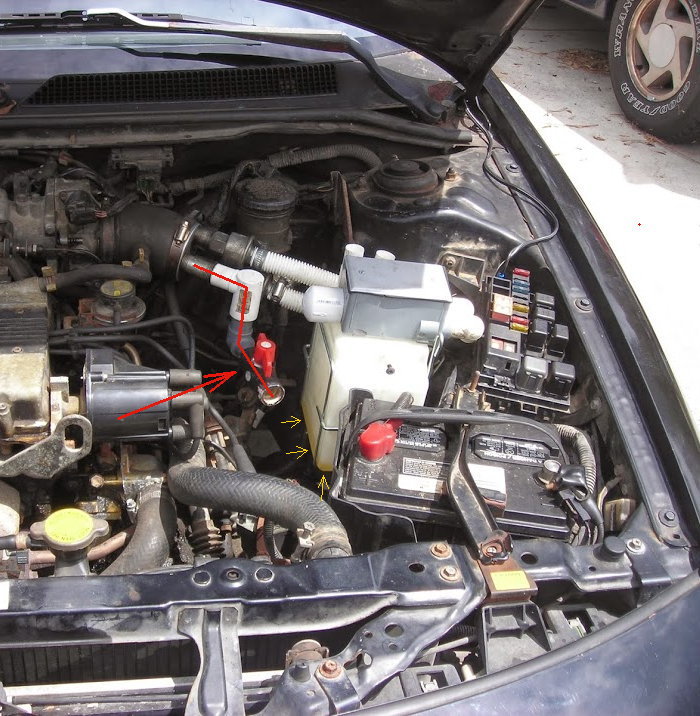
“I learned … on my Geo Storm by using the standard 87 octane gasoline, then 89 octane, then used Coleman fuel(for lanterns), then charcoal lighter fluid and even rubbing alcohol. On each of the different fuels there was a different setting of the air/vapor mixture for the engine to run smoothly.
Timing and engine sensors
I did NOT change timing or bypass any of the original sensors that are factory installed on our vehicles now-a-days.”
– John Weston
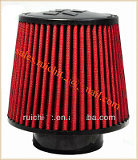
Looks like John removed the air filter in order to find room for his vapor system. The pictures I’ve seen of newer cars makes it look like they keep putting more and more wires, pipes, and hoses into the engine compartments till there is no room left and it costs more and more to service them. Another reason to get an electric vehicle ASAP! Till then, however, we have seen “after market” air filters small enough that he could probably fit one in beside his vapor tank and run one hose from it into his tank and a second one into the valve (letting in the variable amount of extra air).
2 options: get all or part of the air from your air cleaner:
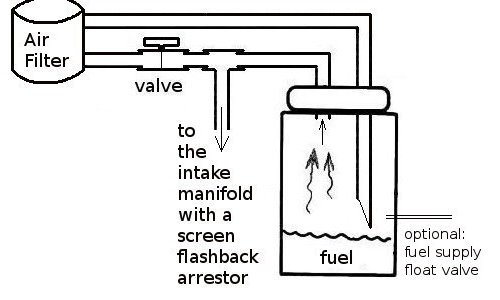
Alternately, the tube bringing air to the bottle/container can come from the exhaust manifold instead of from the air cleaner – to keep the fuel warm.
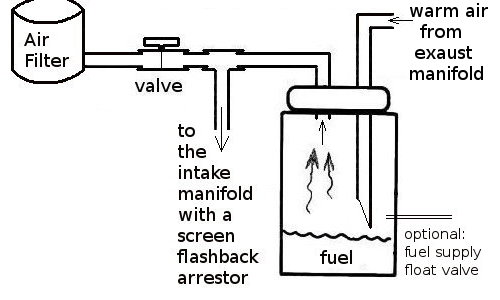
“What I am doing with that is adding an exhaust gas recirculation setup.” – David Trowbridge (91CavGT)
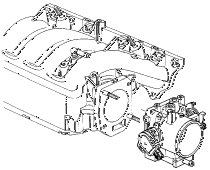
“In a gasoline internal combustion engine, the throttle is a [butterfly] valve that directly regulates the amount of air entering the engine, indirectly controlling the charge” (vapor + air) . . . placed on the entrance of the intake manifold, or housed in the throttle body. The throttle body is usually attached to the intake manifold, and the mass airflow sensor may be mounted on the throttle body.

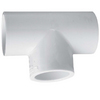

the T fitting: 1 inch diam. = $3
1 inch diam. vinyl tubing = $3/ft
at your local hardware store
We also found 1.5 inch diam. valves, T-fittings, tubing, etc. – which are larger than necessary – unless you have a large V8 ?
{We found all these on-line at a local hardware store, in pluming and in garden supplies}
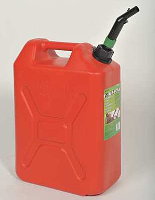
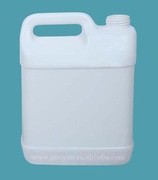
. . . we still need a container and there are commercially available plastic gasoline cans/bottles – made of HDPE (High Density PolyEthylene). Look for any sturdy bottle made of HDPE. (like a 5 quart bottle of motor oil) (embossed in the bottom of the bottle . . . PS: One guy tried a thin-walled milk jug (not HDPE!) and it melted in minutes, another tried a (thicker walled) laundry detergent bottle and it was fine for the time that he had it.)  Or, get a small HDPE or a glass bottle – too small we would think but we will put the hose so far down that it bubbles up through the gas and get lots of vapor from a small bottle – tall enough that the gas won’t spray clear up to the top where the air and vapor is going out to the air filter, engine.
Or, get a small HDPE or a glass bottle – too small we would think but we will put the hose so far down that it bubbles up through the gas and get lots of vapor from a small bottle – tall enough that the gas won’t spray clear up to the top where the air and vapor is going out to the air filter, engine.
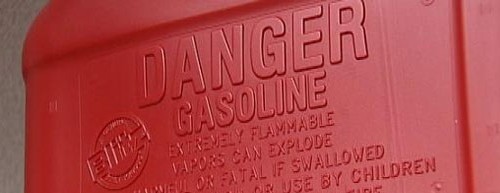
www.attorney-group.com/lawsuits/products-liability/blitz-gas-can-explosion-lawsuits/
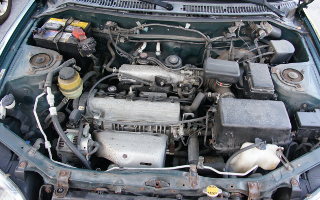
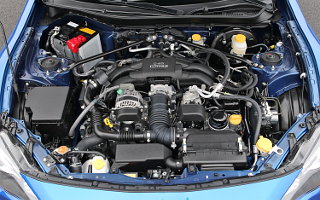
we might want to pull out the large air filter box to gain room for our vapor jar and
then put in our own small “dry-flow” air filter (do a google search to learn about them)
you must look at your engine compartment and decide – ask a mechanic, do some google searches
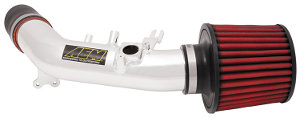
You don’t need to be concerned about it right now, but . . . after you have experimented and finally gotten to the point where you would like the gas level to be maintained in the bottom of your bottle, simple mechanical float valves are cheap and then you can connect the fuel line to it (which you have kept disconnected till now) 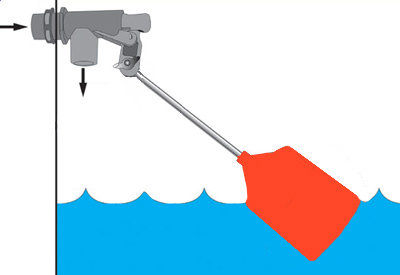 or connect your own secondary bottle of gas and forget the big tank under the trunk entirely – leave it empty.
or connect your own secondary bottle of gas and forget the big tank under the trunk entirely – leave it empty.
For extended periods (depending on how warm the weather is, etc.) the evaporation may cause the gasoline and bottle to get cold and therefore not produce as much vapor – and loose power, so you may want to locate it somewhere to keep it warm – near the radiator or re-direct the exaust or … whatever. Read comments from others on this page.
run your motorcycle on gas fumes
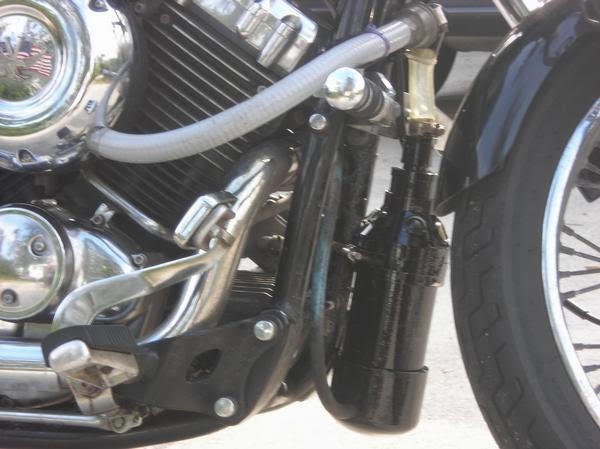
Published on May 3, 2012
Experience: Extending an air tube all the way into the gasoline so as to cause bubbling is not necessary – his car ran even better on the leaner vapor mixture. Conclusion: Little to no bubbling is required. and he uses something smaller than a huge bucket.
Here is a pick-up truck running very very efficiently on vapor from a gas can.
Timing
“There is some confusion out there about having to adjust the timing, change the time the injectors inject the vapor etc. From the tests I have done there is no need for this. Gasoline vapor still burns at the same rate as liquid gasoline being injected into you engine. We need to remember that even with liquid gas being injected the only thing that burns is the vapor coming off the liquid that is why injecting a liquid is so inefficient.”
– www.youtube.com/watch?v=WrsFYMP4BaE
another lawn mower running on fumes!
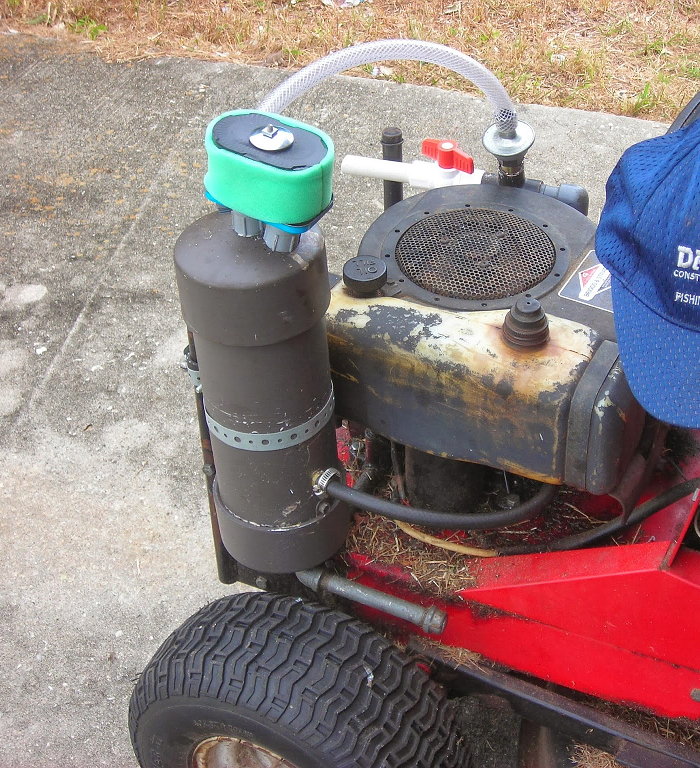
(white with a red valve). See a smaller bottle of fumes powering a motorcycle, above.
* * In The Snow * *
Starting a truck in the snow with only fumes,
running very very efficiently.
hydroman911:
You can see the snow coming down, toward the end, when he pulls the camera out from under the hood. It actually started quicker and easier than a lot of old cars in cold weather.
Converting a lawn mower to run much more efficiently on gas vapor
David Trowbridge (91CavGT) 05-08-2011
Hello everyone. I’m new here (www.whenshtf.com) but I wanted to share this project that I have been working on because I think it would help out a lot of people.
My idea is simple. All you need to do is to have air bubble up through your fuel container, then send this rich fuel vapor to the engine via hoses and control valves. I spent about $30 on valves and pipe to make my setup work.
I removed the fuel tank and mounted it to the bottom of the lawn mower handle. I ran a hose from the normal outlet to above the fuel tank and secured the hose. This is the air inlet. I then took the gas cap and drilled a hole in it so that I could bolt a barbed hose fitting on to it. This hose then goes to a ball valve so I can control how much fuel goes into the engine. This ball valve is connected to a T fitting. I then have another ball valve connected to the T fitting and I use this valve to adjust how much air goes into the engine. The last side of the T fitting then goes to the engine where the carb was, it’s as easy as that!! Another advantage to this setup is the application of a vacuum to the fuel. This lowers the boiling point of the fuel without changing it’s flash point!!
You see some fittings coming off of the exhaust. What I am doing with that is adding an exhaust gas recirculation setup. This will help to [warm] the combustion and should increase the reliability of the setup.
I am also looking to try to find some vacuum operated valves so it will automatically keep the engine running instead of me having to adjust the air and fuel valves to keep it running.
Eventually I want to install this setup on a car.
http://www.whenshtf.com/threads/40702-Converting-a-gas-engine-to-run-on-gas-vapor-to-extend-fuel-range
I did a google search on running on gas vapors and found a lot of people who are experimenting.
The Ogle Vapor System
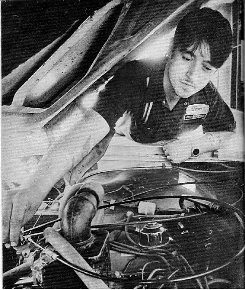
Argosy Magazine had a five-page article about Tom Ogle and the media witnessed test of the “Oglemobile”. On that test run, Tom Ogle achieved more than 100 MPG in a 4,600 pound 1970 Ford Galaxie.Tom Ogle was granted patent # 4,177,779 on Dec. 11th, 1979
“It all started with a lawn mower”
“I was messing around with a lawn-mower when I accidentally knocked a hole in its fuel tank. I put a vacuum line running from the tank straight into the carburetor inlet. I just let it run and it kept running and running but the fuel level stayed the same. I got excited. The lawn-mower was running without a carburetor and getting tremendous efficiency.”
El Paso Times (Texas) Sunday, May 1, 1977; By John Doussard
“200 Miles On Two Gallons Of Gas”
“The odd thing about Ogle’s system is that doesn’t add complex gadgets and intricate gimmicks. Instead, it removes the carburetor, a piece of the engine long considered sacred.”
“Engineers said it wouldn’t work because without a carburetor there’s nothing to vaporize the fuel,” Ogle explained during the trip across the hot dessert. “They couldn’t understand that it’s already working on vapors.
“Instead everybody kept trying to add something to the carburetor while nobody thought of taking the thing off.” [today, we disconnect the fuel line going to the injectors]
“Basically the system uses a standard engine with a few modifications … there are a series of hoses feeding a mixture of gas vapors and air directly into the engine.”
from the NEWS DEMOCRAT JOURNAL of 7/20/2005,
By KEVIN KIDD (Staff writer)
Self-taught mechanic claims 1970 Plymouth runs on gas fumes
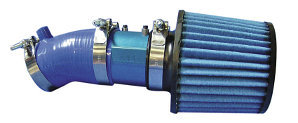
Bill Caine 59, turns, over the modified engine of his 1970 Plymouth Fury and lets it warm up for about 10 minutes. He detaches the gas line and something unusual happens – the car keeps running even when Caine revs the engine past 4,000 revolutions per minute. “I’ve -always been taught the proofs in the pudding,” Caine said. “The only way to prove something is to do it. I’ve had it running without the gas line for three hours straight before.”
The Hillsboro auto dealer with a mechanical inclination has built a vaporizer for the car’s engine to allow the Plymouth Fury to run on gasoline fumes. It’s an attempt at handily conserving fuel. “I started on it back in the ’80s and I figured the way things are now with emissions and gas prices, it’s probably a good time to start it up again,” Caine said.
Caine proudly displays several local and national newspaper articles from 1981 about his innovative work on engines. Many of them proclaim that a full-size car modified by Caine was getting 50 miles per gallon and that he had hoped to stretch the number to 100. He declines to disclose why he scrapped the project just after Japanese manufacturers had began to show interest in his work. Now he has picked up where he left off and has his car running on gas fumes. Caine said his Fury puts out no emissions once the fuel line is detached, “It’s got more throttle response too,” Caine said. “The, motor runs smoother and it gets more power. The most explosive part of gas is the fumes.”
Caine’s next step is to measure the car’s gas mileage. “That’s what I’m going to be working next,” Caine said. “I got the emissions down that’s done. “My hope is to get it to produce the mileage I want it to and then I’d like to put (the vaporizer attachment) on every car on the highway.” Caine chose a 1970 Fury for the project because it’s a big old heavy boat, 4,200 pounds. “We get mileage up on this and just think what that would do to a little car,” Caine said. The vaporizer he has constructed fits on the Fury’s carburetor. He would like the vaporizer to eventually replace the mechanism.
“I want to get it where it bolts right where the carburetor is and take the carburetor off,” Caine said. “Same thing for fuel injected cars. “Carburetors and fuel injectors are wasted parts. I say that because they force-feed the engine.” This innovative thinking comes from a man with no formal mechanical training, just hand-on experience and a dream. “I had an older brother who piddled who around with old cars when I was little,” Caine said. “I put my first motor together when I was 13 years old. …”
yaz:
Kickass work Plasmastudent77!!Last week on the show “TRUCKS!” The guys did a propane conversion on a 2008 Ford 150. They bought the kit and all they changed were the injectors added a pressure regulator/switch and get the trucks computer flashed. There was NO WATER INJECTION needed to keep the valves cool!!
Whoever said, that you need extra fuel to cool valves is full of it!The auto makers that program the computer to dump extra fuel so it “cools the valves” is just an excuse to waste more fuel! It just carbons up your engine faster and dirties up your oil all to get you back to the pumps faster!
http://ezinearticles.com/?Propane-Auto-Conversions—Is-it-a-Better-Solution-For-My-Engine?&id=1518811
The guys on TRUCKS also talked to a guy with a towing business that only used propane for his tow truck and it had over 380,000 miles on it. He said he tore the engine down to rebuild it and guess what?…There was NO carbon buildup... NO unusual wear patterns … the inside of the engine looked almost new and he didn’t have to change the oil as often as he did before when it ran on gasoline…duh! Oh Yeah, no burnt valves!!
Not sure where this stupid rumor started about burnt valves but every natural gas/propane converted vehicle does NOT have anything to cool the valves!!! So stop spreading bullshit!
Instead of trying to improve the vapor setup we’re now sidetracked how to add a water injector…you don’t need it.
Now you will need a fuel heater, because when the fuel vaporizes it cools so after a while the fuel won’t want to vaporize that well especially in the winter. That’s what we need to work on.
Thermal Catalytic Cracking Heating the gas:
Heating gasoline helps break down the larger molecules into smaller, more easily vaporized, molecules for more complete vaporization. In its extreme, it is called Thermal Catalytic Cracking (TCC).
78-year-old North Port, Florida retiree Peter Simmons got 120 to 150 miles per gallon with his vapor system.
GREG MARTIN, Charlotte Sun staff writer; Posted October 18, 2007
“…every time we got up to 145 mpg or better, we’d say, ‘Gee whiz!'”
Simmons, who was born in New Zealand and raised in England, said he suspects Big Oil has kept such innovations secret to protect profits. “It is my opinion that all this stuff has been kept quiet and unknown by the poor unsuspecting public,” he said. “They’ve all been taken for the biggest ride in history. We could have been getting 100 miles per gallon.”
He has held that suspicion since the early 1950s, when he worked to develop a vapor carburetor with an engineering colleague he identified as Roy Lewelling. The two men obtained crude plans for a vapor carburetor from an advertisement in one of the amateur engineering magazines that were popular in England at the time. “The advertisements sounded like a stupid dream and a con, with promises of a complete description of a carburetor that would get fantastic mileage,” Simmons recalled.
But Simmons said he was already a believer because he’d heard a legend that the British Army, under Maj. Gen. Bernard Montgomery, had used vapor carburetors in its tanks and artillery trucks to chase Germany’s Erwin Rommel from Egypt to Tunisia during World War II. The route began with what Montgomery had dubbed “Operation Supercharge” in November 1942. “Montgomery was able to get all the way to Tunis, I think, on one refueling,” said Simmons, who served in the British Army’s engineering division after the war. …
Old-time tinkering
Simmons said he and Lewelling began tinkering with the goal of creating what they dubbed the “Pogue type 2” carburetor. It was based on the concept of the Pogue carburetor, invented by Canadian Charles Nelson Pogue in 1927. It used a radiator-like device to heat the gasoline. An article about the Pogue carburetor in the May 1936 edition of the Canadian Automotive Trade magazine carried the headline: “Prominent automotive men convinced over 200 mpg possible.” …
Simmons said they carefully measured the mileage they achieved and he’s convinced it reached as high as 150 mpg. The results were tempered by two caveats: it ran only on “white gasoline,” a pure form of gasoline which was not readily available except to the military, and the mileage was based on imperial gallons, which are one-sixth bigger than U.S. gallons. After several years of development, the project was dropped in 1953. Simmons said both he and his colleague were courting their future wives at the time and chose to devote more time to their regular careers.
see original story at:
http://m.naplesnews.com/news/2007/oct/09/port_charlotte_man_claims_device_can_boost_car_mil/
The Gasoline Vapor Maker
as described by Frank E.
“Here are the plans which I drew up in about 1970. George’s buddy from the midwest made one, and others have been made. So I advertised “The Gasoline Vapor Maker” in a national magazine. I sold a few. Then I got a nasty, threatening letter, and got cold feet. So I wrote to all the buyers and offered them their money back if they returned the plans. Two or three came back for refunds, the rest were kept by the buyers, who I never heard from again.
However, from that time on, everybody and his brother started advertising my plans. Of course they were changed in an attempt to make it unrecognizable so that they wouldn’t look like copies my plans. Now the cat was really out of the bag, and the petroleum industry couldn’t threaten and scare that many people.
. . .
WWII
Pogue helps the British defeat Rommel
A friend of mine used to go up to Winnepeg, Canada in the 1980’s to visit Pogue who was living in a Nursing Home at the time. One of the stories that Pogue told him was about the Battle of El Alamein that was the turning point of WW II. Previous to this battle, Rommel’s Tank Corps would chase the British tanks till they ran out of gas. Rommel’s tanks would then retire and allow the artillery to destroy the British tanks. They could do this because they had more efficient engines with a longer range.
Pogue had been hired to design a combustion system for our tanks that gave them a greater range than Rommel’s tanks. At the battle of El Alamein, our tanks ran Rommel’s tanks out of gas and our artillery picked them off like ducks in a shooting gallery. Whenever one of our tanks with Pogue’s combustion system was disabled or destroyed, there was a crew who would dismantle and remove the combustion system in these tanks that were sealed in a black steel box.
There is a website and a CD that have 604 carburetor patents that have been assigned to various companies and never developed. There were 53 inventors who wouldn’t sell out. Each of them had fatal “accidents” two to three weeks after refusing to sell their patent(s). I knew four of these inventors personally. The website is http://www.fuelvapors.com/.
Phil Ratte is a retired mechanical engineer, who graduated from the University of Minnesota with a BME (Bachelor of Mechanical Engineering) degree in 1961. A few years later he got his license as a Registered Professional Engineer in the State of Minnesota and later in the State of Wisconsin.
In 1978, Phil ran for the U.S. Senate on a platform of new energy related ideas that included ethanol blended fuels.
From 1979 to the present, Mr. Ratte has tested over 90 devices and additives that promised to save fuel and reduce pollution.
. . .
From 1981 to 1989, Phil worked with a wealthy inventor, Herb Hansen, to develop two prototypes vehicles that ran on 1/3 ethanol and 2/3 water. Herb died of a major stroke at a very convenient time for the Oil Cartel. Two months after Herb died the U.S. Secret Service entered Phil’s home with a warrant and copied his files on their ethanol project. When he tried to find out what the Probable Cause was to issue the warrant, he found that the Federal Judge had sealed the file. Phil has known 4 men including Herb who died after refusing big money for their very promising energy saving devices.
53 inventors with revolutionary energy saving inventions have met untimely “accidental” deaths just after refusing large sums of money for their patents. Other inventors have received millions of dollars for their patents that were then left undeveloped. Phil says he has a CD that has 920 energy saving patents in it that were assigned (sold) to various automobile, oil, and other companies and then buried.
In the 1990’s, Phil was hired to do testing for two companies that were selling magnetic fuel saving devices. He appeared as an expert witness in a criminal trial in Missouri. His success there caused the 29 states that were prosecuting the second magnet company to quietly drop their cases. It also caused the Minnesota Attorney General to try to attack Phil’s Minnesota Professional Engineering license. That Attorney General was Hubert H. Humphrey III who Phil helped Jesse Ventura defeat for Governor in 1998.
It is very strange, says Phil, that after 1994 magnets could no longer improve fuel efficiency. Apparently the computer chips in cars after that time were programmed to defeat any device like the magnets that provided more complete burning of the fuel and potential fuel savings. (Any underground programmers out there who can re-program these chips to take advantage of novel fuels?)
http://blog.hasslberger.com/2007/04/pogue_carburetor_gasoline_vapo.html
“Gasoline has additives in it that will not burn. … Even higher mileage can be obtained by heating the fuel…”
“Much to do has been made of bypassing the car’s computers. The OBD computer system is on vehicles after 1998. Unbelievable as it is, the computer is designed to waste fuel. If you put a small amount of hydrogen or a small amount of gasoline vapor (as is featured in this video), your oxygen sensors falsely show that you are running “too lean,” and the computer tells the car to waste more fuel. That is because the injectors are controlled by the computer.
We can show you how to do something no one else is showing. How to completely turn your injectors off, and put pure vapor into the top of your motor and bypass your computer. When the computer tells the injectors to waste more of your precious fuel, nothing happens. Surprise, surprise, you have disconnected your injectors, and you are running on vapor! The computer does not interfere with the timing, or shut the motor off!
When you set a glass of water on top of the motor running on liquid gasoline, it jiggles the water in the glass. But when you set a glass of water on top of the motor running on gasoline vapor, the water does not jiggle. Vapor runs your engine smoothly.
http://www.runningonvapor.com/gallery.html
“We took a gasoline generator, removed the gas tank, air filter, and carburetor (did not need to remove the carb. but did) and put about an oz. or two of gas from the nearly empty gas tank on the generator into a plastic bottle.
Note: only one hose – since the lid was off – just like the first video at the top of this page. No bubbling.
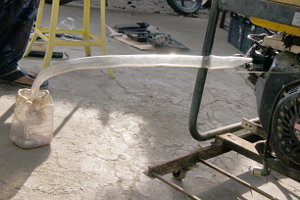
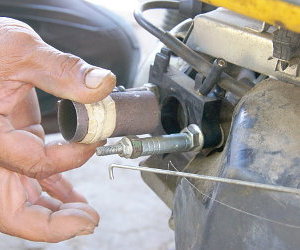
We chose to use a 3 ft long hose with a short metal extension tube fitted in the hole exposed by removal of the carb.
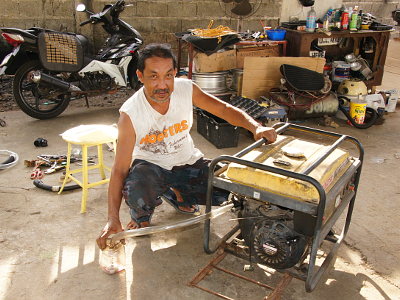
It backfired a number of times (for a few seconds) before the vapor smoothed out and the generator took off and rather quickly revved up to full speed and stayed there! Since we had taken the carburetor off with its butterfly valve for speed control, we had no control over it. After watching it run at full speed for a few moments, we turned it off. Far out! It worked as it should. Next, he will put on a carb.
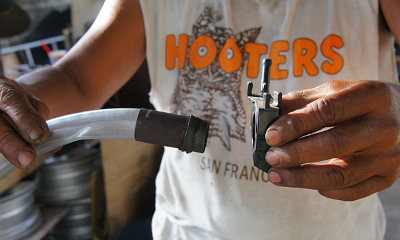
Super Carburetors
Charles Pogue Carb.
Car gets 400+ MPG John Weston
Tom Ogle Carb.
Ogle in Argosy mag.
A Hydrogen Generator You Can Build







I watched the videos but I’m see no mention of whether it would work on Mass Air Flow, What to do with the fuel injectors and finally controlling throttle. There is no mention of how to increase vapor volume on demand. The fact of using fuel vapors is ideal I get that. But this comes across like the HHO hoax! Who ever is presenting these videos needs to show a car like mine, A 2005 Toyota Corolla. Lawnmowers, generators etc.. the idle for the most part is fixed. Big difference than a car.
Ray M.
using your accelerator cable is mentioned in several places. Ignore the fuel injectors; let them sit there. We have videos of a Buick, 2 Dodge trucks (old and new), pictures of a (fuel injected) Geo Storm, and more. There are others on youTube. You can read about your mass air flow sensor and figure it out.
Submitted on 2014/08/24 at 10:35 pm
I was just asking basically do people that are doing this on newer cars just unplug the injector harness?
Also if this vapor induction is so efficient how do you go about calibrating the ECU so the excess oxygen in the exhaust doesn’t cause the O2 sensor to cause a code.
Ray M.
I apologize, but the accelerator cable is mentioned several times and I read that your “MAF” is to control fuel to the injectors – which is no longer relevant. If it causes trouble, disconnect it. The harness has not been mentioned but surely it just gets in the way, true. The 2006 Buick and the 2004 Dodge Ram are not so old (see above videos) (I was surprised that old Dodge truck still used a carburetor.)
Given injectors, not carbs., the differences are basically things that have been added to control emissions etc. and are almost all irrelevant. We just have to disconnect them if they cause trouble. (do a google search if necessary)
Submitted on 2014/08/25 at 1:21 pm
Apology Excepted. I know at this time there is manual controllers for the pulse width of the O2 sensor but nothing that can automatically calibrate the pulse width on demand on the Open Source. I have a 1988 ford ranger 2.9L V6 EFI. This is the vehicle I’d really want this to work on. Reason is The emissions fail only because the new laws are to strict for this year of truck. The techs at the inspection station said my trucks emissions are as good as when it was new. Just the laws for lower emissions are strict. Has anyone got results for NOX emissions? I saw the results for CO and CO2 and Fuel/air ratios and there great for vapor systems. I will do some digging on the O2 dilemma if I run across something I’ll share it. Thanks!
Ray M.
would like to try this on 92 suburban can i get a kit if so the cost or i do a linberry and what about a firer under the hood info please thanks. jv
get a bottle and some hose – run the hose into your air filter … go for it!
I wonder if the acceleration is much slower with the vapor set up.? Lee Brown
read – watch the videos also.
Read: “It’s got more throttle response too,” Caine said. “The motor runs smoother and it gets more power”, “his car ran even better on the leaner vapor mixture.” and “Here is a pick-up truck running very very efficiently on vapor from a gas can.”
The oil co’s have trained everyone to be as dumb as dodo birds – to refuse to even read. It’s time for everyone to start reading and learning a few things.
I’m building one with anti splash for my 87 k5 lifted on 35s running a semi built 350/700r4 and 208 transfer.
Joshua in Joplin mo
Great. Good luck.
im fixing to make custome tanks for these give me random dimensions you want and ill sketch it out and you tell me what you would like it to look like i might do some skulls dragons you name it let me know.
dalton stringer
Please send me any drawings you may have PLEASE? I am retired with not much money coming in Please??? Thank You Very Much, If you ever come to Oz contact me at 61-07-4168-9780 OK? OK.
Kent Swanbeck, Australia
Kent, All our information is here. If you need assistance, a friend or neighbor might help.
Will this work on a 09 Chevy Tahoe V8 gasoline engine?
Basil Mack
We heard that the Chevy Tahoe only runs on Miller High Life or Bud Light but you can put a little gasoline in the bottom of a bottle and try it like the others have done here.
Basil,
The short answer is Yes, it will work on your 09 Chevy Tahoe.
Chris
If you are pulling air through the gasoline are you not going to get the O2 needed for the combustion as well for higher spped/horsepower as well?
watch the videos. Read.
I am interested to know details about doing this with my riding and pushing lawnmowers. Is it easier or more difficult than doing in on a car? Does anyone know of a kit I can buy for my mowers to do this, or do I have to Gerry-rig my own system?
gw
I did this to my 78 Toyota yesterday. It was a lot like the guy with the Buick. It cost around $60 for everything. I completed it in about 4 hours and got videos of it running in the shop and going down the road at 50mph. It was so easy I wouldn’t have believed it if I wasn’t driving it. I’ll put up the pictures and videos soon. It’s still rigged right now but once I get it dialed in I plan on making a nice tank to fit and cleaning it up.
GREAT! Create your video showing everyone all the parts and telling how you did it, and that even “rigged” it still works. Give us the link(s) to see it!
great site I have always known vapor was the best way to burn the fuel and had been looking to make a vaporizing carb or injector . this is much simpler . great site
mr. pink
thank you
So you crank the truck with the key? Right. So can you stop it with the key too?
Dale Lewis
Dale,
You start and shut the engine off the same as you always have. Nothing changes but the type of fuel and delivery method to the engine.
Chris K.
This site is awesome! Thank you so much for all this information. I can’t wait to try it.
Mike White
Thank you.
Do I need to run fumes through the fuel injectors or just the intake manifold?
Bob Dooley
fuel injectors are only open for about a thousandth of a second
I have a 94 Nissan pickup with fuel injection. I was thinking of putting a shutoff valve in the fuel line just before the injectors and shutting the fuel off after switching to vapors. Does that sound like the right approach to take with fuel injection?
Hi Bob,
I was reading through this website when I saw your question about shutting off the fuel injectors. To shut off the fuel flow, don’t use a shutoff valve on the fuel line but pull the fuse for the fuel pump itself to shut it off altogether. Otherwise, the fuel pump will continue running and straining to push the gas when the shutoff valves are closed and the pump would burn itself out. You won’t be needing the pump anymore when running on vapors. I hope this helps you out. I wish you good luck with your vapor project. I’ll be trying it myself soon too.
Chris
ps: Run the fumes through the intake manifold for the continuous flow. Fuel injectors won’t do that, nor can they.
Can diesel vehicles use this system?
Do a google search on running on diesel vapor. We believe there are several youtube videos of people doing it. Yes.
I think one of the best ways of promoting your spectacular invention is by trining the trainers, meaning you have to train interested and honest individuals on how to learn your technology and then they will be training transport operators, bus owners, taxi owners, etc for a fee. I am sure they will be happy for the savings that they will generate by using your technology. I have been a trainer before but not in your line of business, but if you are going to train me I will be more than willing to promote and spread your technology.
– Abel V. Lagran
You are making it too hard. get a couple bottles and go to it. Then show your friends.
Hi,
I love this website and all the information. Thank you! Can any of you make any suggestions on the best and simplest way to convert a 1995 Cadillac Deville to vapor gas? I appreciate it! I can hardly afford these gas prices—especially since I now have a small business.
I’m vary interested in making one of my own for my 2000 Nissan Maxima. Right now I get about 20mpg city and 28mpg highway and gas prices are really killing me. Would anyone be willing to give me instructions on how to make one so I can put it in myself. Please. If you could my email is harichardson94 [at] gmail.com thank you.
I have not had a carbureted car in more than 20 years. How will this work on a modern, injected engine? What changes will I need to make? My daily driver is a 2000 Jaguar XK-8.
Rick Allen
None of the cars in these videos have carburetors.